.
|
Lens
|
|
|
Box contents
|
Front and rear caps, hood and users manual.
|
|
Cost
|
$848 retail
|
|
Build quality
|
Very good
|
|
Additional information
|
Has focus hold button and focus limiter switch. Longer working distance than the smaller 50mm macro.
|
| Specifications below |
|
|
Optical configuration
|
8 elements in 8 groups
|
|
Angle of view
|
24° (full frame) 16° (APS-C)
|
|
Aperture
|
9 blades, circular
|
|
Full frame and APS-C
|
Yes, made for full frame. APS-C equivalent, 150mm
|
|
Depth of field and focus scales?
|
Yes and yes
|
|
Minimum focus, image plane to subject
|
14.4″ (350mm)
|
|
Minimum focus, end of lens barrel to subject
|
6.2″ (157mm)
|
|
Hard stop at infinity focus?
|
No
|
|
Length changes when focusing?
|
Yes
|
|
Focus ring turns in AF?
|
No
|
|
Filter size
|
55mm
|
|
Filter ring rotates?
|
No
|
|
Distance encoder?
|
Yes
|
|
Max magnification
|
1:1
|
|
Min. F/stop
|
F/32
|
|
Sony teleconverter compatible?
|
No
|
|
Dimensions W x L (my measurements)
|
2.9″ x 3.9″ 75mm x 99mm
|
|
Maximum extended length (my measurements)
|
5.8″ (147mm)
|
|
Weight bare (my scale)
|
17.1oz (484g) 17.9oz (508g) with caps
|
Requisite product shots.
 |
| Box and contents. |
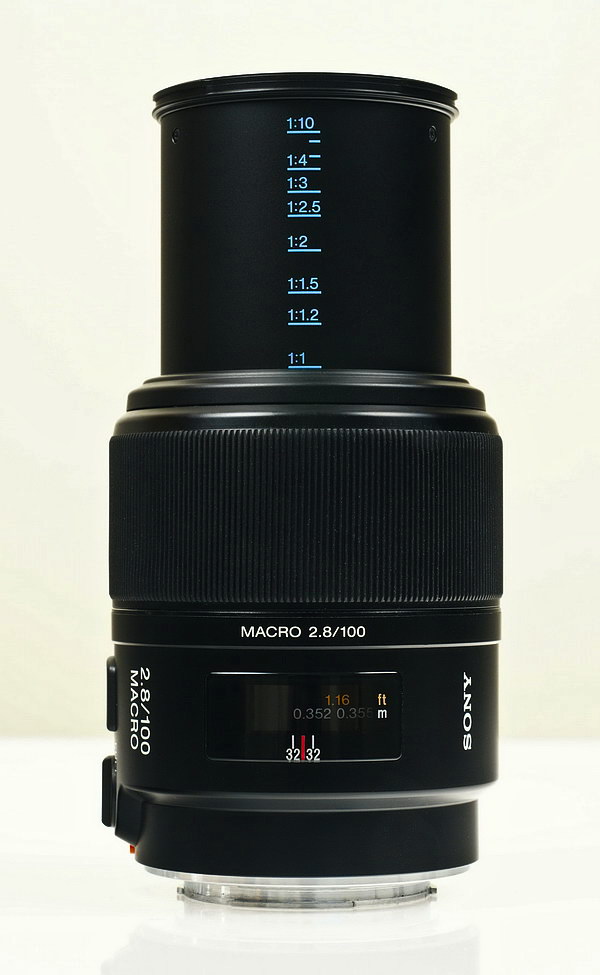 |
| Fully extended. |
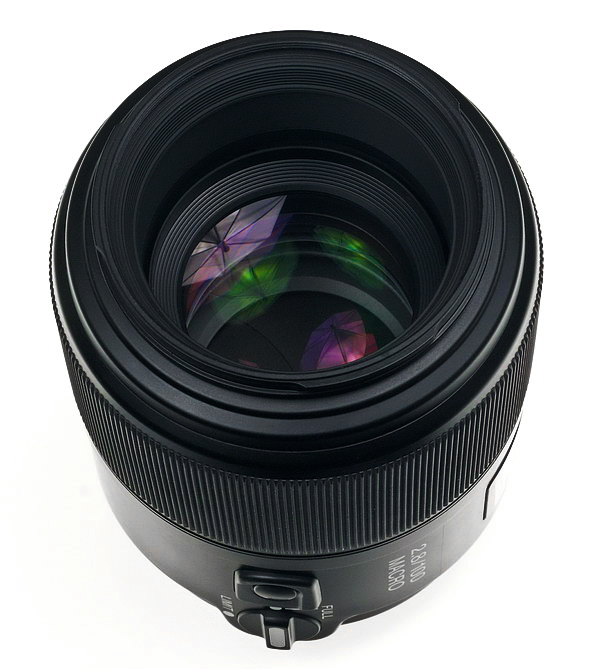 |
| Deep front element. |
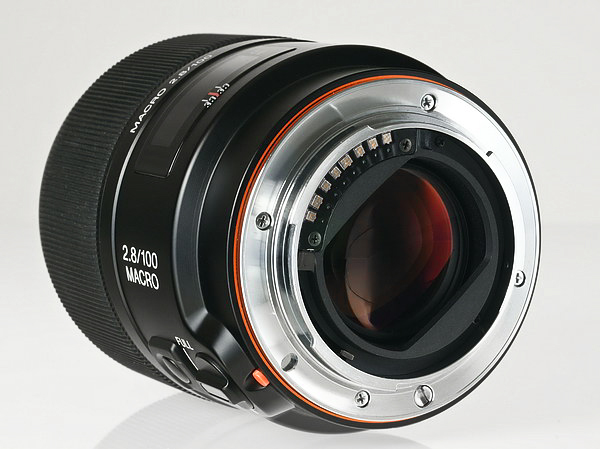 |
| Backside. |
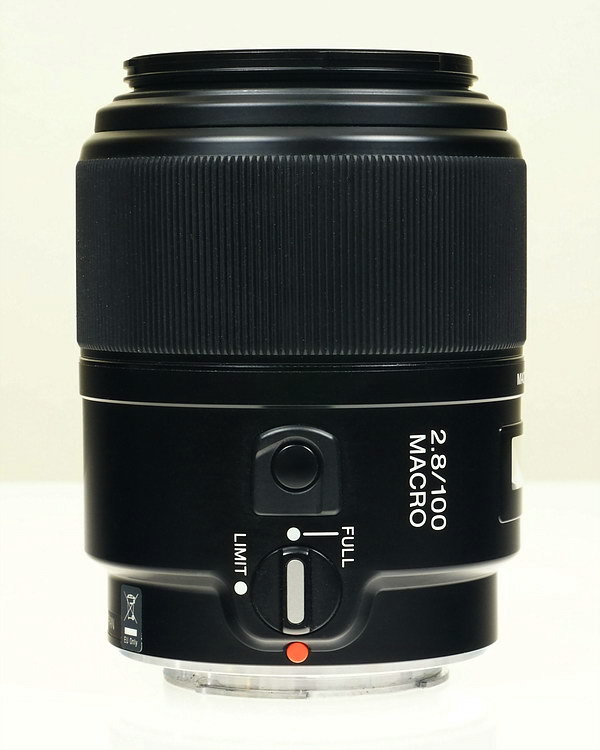 |
| Focus limiter and focus hold buttons. |
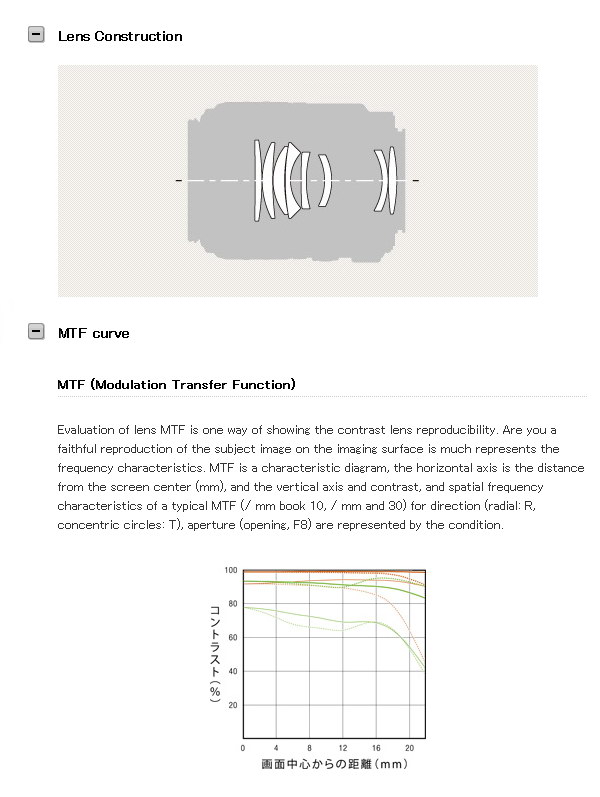 |
| Sony X-ray view and MTF chart |
Lens flare/ghosting. No problems unless the sun is at a certain angle, see images below. Veiling glare is about average. Additionally, the lens has plenty of recess for the front element from about 1:2 to infinity focus. At 1:2 macro and closer, the lens comes out towards the front which can exacerbate ghosting, but that shouldn’t be a problem when you’re shooting macro type subjects. You don’t need to use the hood with this lens unless super bright lights are near the camera front, and even then it doesn’t seem to make much difference, use your hand for best results, and the elimination of glare. This lens shares the same hood with the 75-300mm lens, replacement cost, $25.
|
Sun in shot, F/5.6
|
Sun centered, F/5.6
|
 |
 |
|
Bokeh, F/2.8
|
Bokeh, F/4
|
 |
 |
 |
| Mild pincushion distortion. |
Light fall-off, (directly below) No problems at all when using an APS-C sensor camera. Images below were taken at infinity focus.
|
F/2.8
|
F/4
|
 |
 |
Light loss at high magnification.
Here are the approximate F-numbers you will get as you increase the magnification, the table below is from the Sigma 105mm F/2.8 DG macro, but is close to the Sony model. Sony lists exposure compensation in the owners manual, but it’s not nearly as clear as the Sigma table. These numbers will not be indicated on the camera, and will still read F/2.8 even at 1:1 magnification, but look at your shutter speeds and you’ll notice the loss. This is for your information only, so just shoot away, the camera will adjust your exposure automatically. I’m simply providing this in case you’re wondering why your shutter speeds are so low when the LCD says F/2.8.
|
Magnification
|
F-number
|
|
1:40
|
2.8
|
| 1:4 | 3.6 |
| 1:3 | 3.8 |
| 1:2 | 4.2 |
| 1:1.5 | 4.7 |
| 1:1.2 | 5.1 |
| 1:1 | 5.5 |
|
F/2.8
|
F/4
|
 |
 |
|
F/5.6
|
F/8
|
 |
 |
|
F/2.8
|
F/4
|
 |
 |
Requisite macro paragraph. As with all 1:1 life size macros, sometimes it can be a little tough to focus, and a tripod is highly recommended, especially if you go full size. Hand held field shooting is limited to 1:2 in my opinion, any more and you’ll fill up a 16GB memory card trying to get a decent shot. At F/4 the depth of field is razor thin, at F/16 you lose your shutter speed, so some extra though is required before your photo session begins. I often have to bump up the ISO to get a sharp picture with hand-held shooting. Even on a bright sunny day you’ll be surprised at how low your shutter speeds are, and with jittery hands it’s all the worse. If you like to compare shots from other lenses and cameras, don’t be too critical about it at 100% screen size. Getting a uniformly sharp image from a flat object like my stamp is very difficult, especially when it’s a full 1:1 macro. I use the stamp so you will know about how big an area is covered, and get an idea of the sharpness. Keep this in mind when viewing the macros.
Macro shot.
The macro shot is very sharp as expected. It also shows great changes in sharpness from F/2.8 (real soft) to F/8, (real sharp) when photographing small detailed objects like the stamp. Maximum sharpness comes at F/8.
|
Full frame results using the Sony A900 below. Check out the differences when using a film or full frame camera below. I’m only pointing out the noticeable issues as compared to the APS-C bodies, so if I don’t show it here, the results are not significantly different enough to warrant posting an additional set of images in this section.
Light fall-off
Light fall-off shows up more with full frame coverage. At F/2.8 it’s moderate to heavy, and slightly noticeable in real shots, but one stop down and things change dramatically for the better. The corners don’t lighten up any further by stopping down past F/5.6. Images above were taken at infinity focus, at close macro range there’s no problem.
Full image from A900 below. 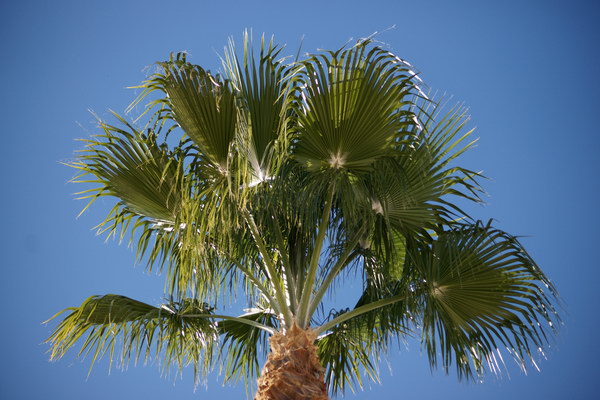
The dark corners are noticeable here, and as usual, the perceived severity depends on subject placement and background. This shot was F2.8, ISO 200, 1/2500sec.
Corner samples next.
The corner sharpness is about the same as the APS-C crops show, although F/2.8 is more soft with full frame coverage. The corners are their absolute best at F/8. The exposure differences are from light fall-off. Don’t compare these crops with the APS-C crops I showed earlier, as they were taken at a different time and distance.
Distortion.
This lens produces some pincushion distortion, and looks slightly stronger than the APS-C image shows. |
.
The Sony 100mm F/2.8 macro is a good lens, but not quite as good as the Sony 50mm macro. It’s pretty sharp through F/4 to F/11, very sharp from F/5.6-8. Color fringing is somewhat strong at wide apertures, but clears up nicely around F/5.6. It focuses good, though keep it on manual up close. The main differences in the Sony 100mm F/2.8 macro and the Sony 50mm F/2.8 macro are; the 50mm is smaller, lighter, less expensive and sharper at F/2.8 and has better CA control. The 50mm has a lens barrel to subject distance at maximum macro of only 1.9″ (48mm) as opposed to the 100mm 6.2″ (157mm) distance. Normally, close working distances will bring you problems with shadows on your subject from the lens, although some people won’t get that close so they won’t be bothered by this. If you shoot a lot of really close macros, you might want to choose this lens over the 50mm macro. Both have a smooth background blur or Bokeh. The Sony 100mm F/2.8 macro could also serve duty as a portrait lens or medium telephoto for low light events where the 50mm might not be enough.
I think the Sony 50mm F/2.8 has about a one stop advantage for sharpness (at or near wide open apertures) and maybe a two stop advantage for color fringing. If you really need the 100mm length, then go for it. If you don’t need the length and would rather have a smaller and lighter lens for convenience, consider the Sony 50mm F/2.8 macro or Tamrom 60mm macro below.
APS-C users; don’t forget to check out the Tamron 60mm F/2 macro lens or super small DT 30mm F/2.8 macro.
For full frame users; as usual, light fall-off is stronger, but that’s about the only real negative I can come up with when comparing the differences in coverage.








